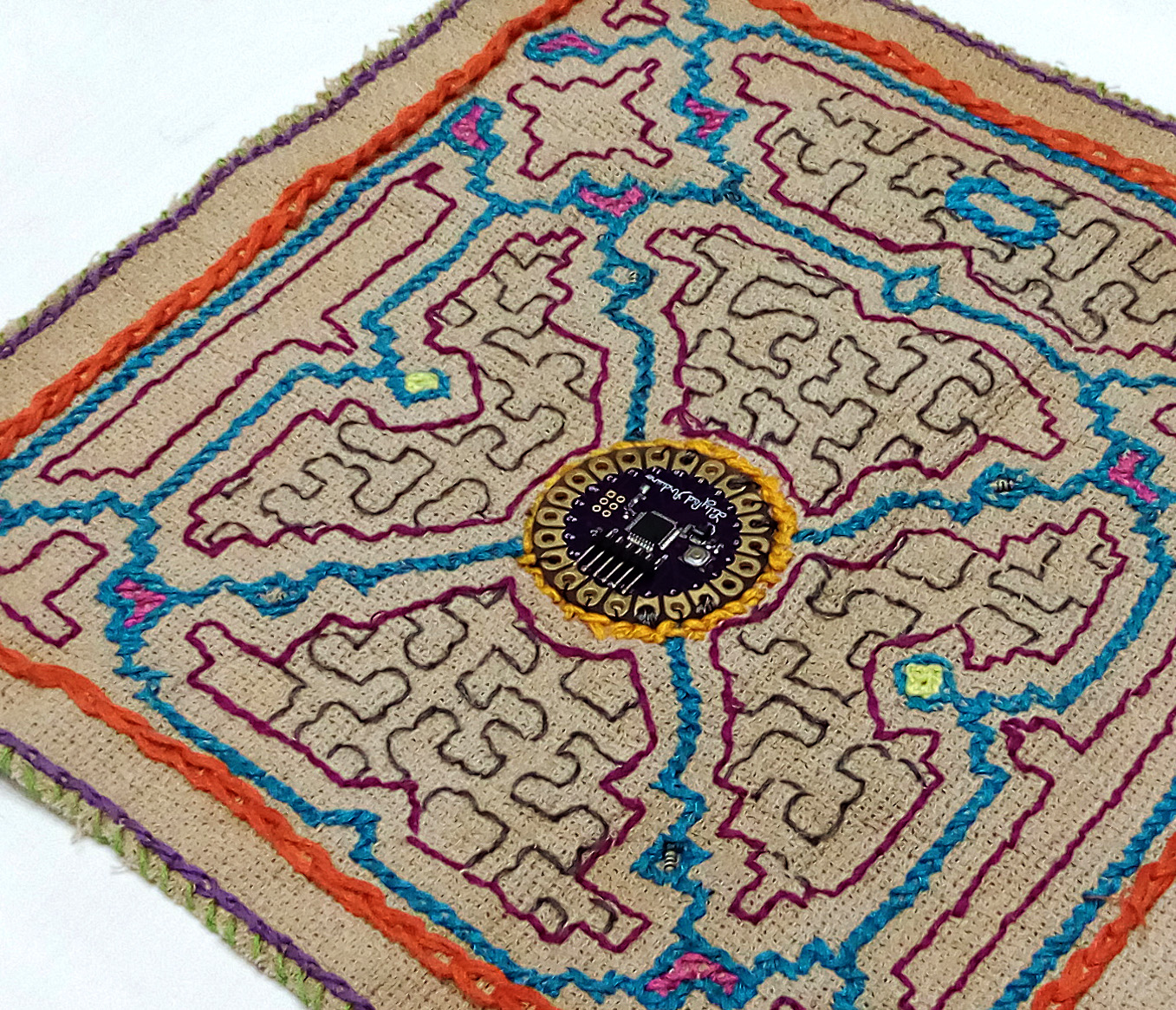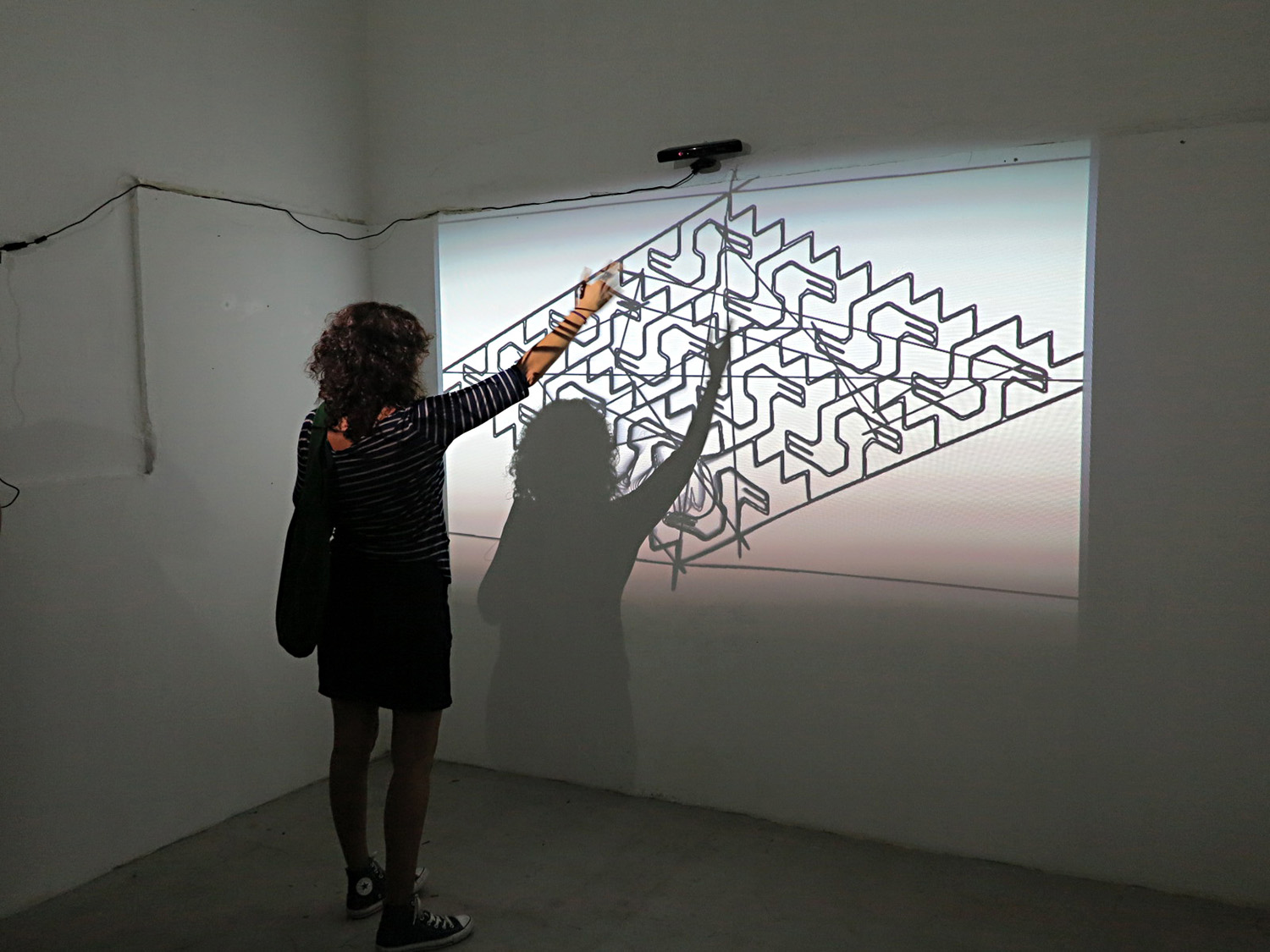Paola Torres Nuñez del Prado
(RE)SONAR

(Re)Sonar: Cuerpos Resonando en la Tecnoesfera
En sus ensayos sobre la pintura, Merleau-Ponty nos relata cómo Valéry solía decir que el pintor lleva su “cuerpo con él”, cosa que toma sentido cuando nos damos cuenta que somos incapaces de imaginar cómo una mente podría pintar. Sería por esta suerte de préstamo del cuerpo al mundo que uno, como artista, cambia a este mismo a través del arte; para entender esto debemos regresar al mismo soma, al propio cuerpo funcional, que es “un entrelazamiento de visión y movimiento”. No hay sonido sin movimiento, ni movimiento sin tiempo, y en este contexto, incluso el clic del mouse implicaría el hecho de que algún cuerpo —alguien— tiene la intención de señalar o presionar un botón para cambiar algún ajuste en tiempo real.
Thomas Csordas, clave en la estructuración de la antropología contemporánea, se basa en la crítica de la dualidad mente/cuerpo de Merleau Ponty (la separación cartesiana de la experiencia humana) señalando que no sería vista como tal por otras culturas, quienes manejan una forma diferente de ver el cuerpo, más integral: un cuerpo siempre incrustado, encarnado, insertado tanto en el mundo natural como en el cultural. Inicialmente usamos nuestros cuerpos para sobrevivir en el espacio, para de ahí crear herramientas que modifican ese mismo ambiente en el que existimos. Cuando la naturaleza comenzó a ser vista como dada (en lugar de darnos) nos convertimos en usuarios del mundo natural.
En el contexto del arte interactivo, el cuerpo performático deviene en agente de modificación.
(Re)Sonar: bodies resounding in space through technology
In his essays on painting, Merleau-Ponty tells us how Paul Valery used to say that the painter carries his "body with him", which makes sense when we realize that we are unable to imagine how a mind could paint. Indeed, one, as an artist, changes this kind of “body loan” to the world through art; to understand this we must return to the same soma, to the functional body itself, which is "an interweaving of vision and movement". There is no sound without movement, and no movement without time, thus, in this context, even the click of the mouse would imply the fact that some body - someone - has the intention of pointing out or making some adjustment or action in real-time.
Thomas Csordas, key in the structuring of contemporary anthropology, bases his ideas on the critique of the mind / body duality of Merleau Ponty (the cartesian separation of human experience) pointing out that it would not be seen as such (separated) by other cultures, who have a more integral view of it: as body always embedded, embodied, inserted in both the natural and the cultural world. Indeed, we use our bodies to survive in spacetime, to create tools that sculpt that same environment in which we exist. When nature began to be seen as been given to us (instead of giving us) we became the users of the natural world.
In the context of interactive art, the performative body becomes a modifying agent.


Mapas Sónicos:
Ciudades superpuestas // Performances Inducidas
Un chullo tradicional peruano fue convertido en wearable para que así el usuario pudiese escuchar las calles de Lima si éste, primeramente, camina (repitiendo la acción de cuando el mismo audio fue grabado, caminando por el centro de Lima en una suerte de mapeo sonoro a pie) mientras que mantiene la cabeza gacha: el usuario debe cumplir ambas condiciones si quiere escuchar el sonido... De no hacerlo, el sonido se interrumpirá.
Este "electrochullo" funciona a base un acelerómetro y un microcontrolador de tipo Arduino Lilypad, utilizando hilo conductor y dos pequeños parlantes dentro del chullo.
Sonic Maps :: Overlapping Cities
An "Induced Performance" in which a Peruvian chullo was turned into a wearable so the user could hear the streets of Lima if he/she both repeated the same action as when the audio was recorded, that is, thw walking in a sort of sound mapping of the city of Lima, but also, the person had to keep its head down, if it wants to hear the sound - if the user does not do it, the sound will be interrupted. This was achieved through the use of an accelerometer and programming an Arduino-type microcontroller, using electroconductive wire and two small speakers inside the chullo.

Textil Shipibo Conibo Sonificado
Este bordado se basa en los diseños de la comunidad amazónica Shipibo-Conibo, quienes aseguran que estos patrones también se pueden cantar. Fue bordado a mano, de tal manera que el hilo conductor (en gris) se convierte en un sensor reactivo al tacto, integrando el diseño del circuito con el diseño shipibo, e incluyendo al microcontrolador Lilypad que se encuentra en el centro, donde, muchas veces, los artesanos de la comunidad Shipibo colocan el bordado de la chacruna, una planta importante en la preparación de la Ayahuasca. El diseño del hilo conductor, aunque similar a sus diseños, es en realidad una interpretación de la curva de Hilbert.
Shipibo Conibo Sonified Textile
This embroidery is based on the designs of the Amazonian Shipibo Conibo community, who assure that these patterns can also be sung. I did it by hand, in such a way that the wire (in gray) becomes a sensor reactive to the touch, integrating the design of the circuit in the same shipibo design, and including the Lilypad microcontroller in the center, where they, many times, they place the embroidery of the chacruna, an important plant in the preparation of the Ayahuasca, a drink used by the Shipibo shamans. The symmetrical design of the conductive thread, although similar to its designs, is actually an interpretation of the Hilbert curve.
Este controlador funciona con un patch en Pure Data y se puede escuchar aquí:
-
https://soundcloud.com/taq-aut-dios/reasons-temporales
-
https://soundcloud.com/taq-aut-dios/i-brought-the-future-to-the-past
Aquí un ejemplo de su funcionamiento:

Textial v.2
Thread String Line Weave Code Net
El dibujo se basa en los diseños teselados Paracas. Tiene una porción virtual (proyección sobre textil) y una porción física que consiste en hilos que continúan parcialmente los diseños proyectados como animación: un diseño a medio bordar que los visitantes pueden terminar a mano, ya que al final de los hilos cuelgan agujas que pueden ser utilizadas por los asistentes. Lo que el código hace es básicamente volver a dibujar el patrón original (estilo Paracas), interconectando las líneas como si fuera un textil. Es reactivo para las personas que se mueven y bordan en el espacio donde está instalado.
Textial v.2
Thread String Line Weave Web Net Code
The drawing is based on Paracas (Preocolumbian civilization) tesselation designs. It has a virtual portion (projection over textile) and a physical portion that consists of threads that partially continue the designs projected, an unfinished design that visitors can finish by hand, as at the end of the threads, needles can be found. What the code does is basically redraw this pattern, interconnecting the lines as if it would be a textile. It is reactive to people moving and sewing in the space where it is installed.
Conferencia: Hacking the Mind ¿es la mente computable?


Registro en audio de la conferencia
